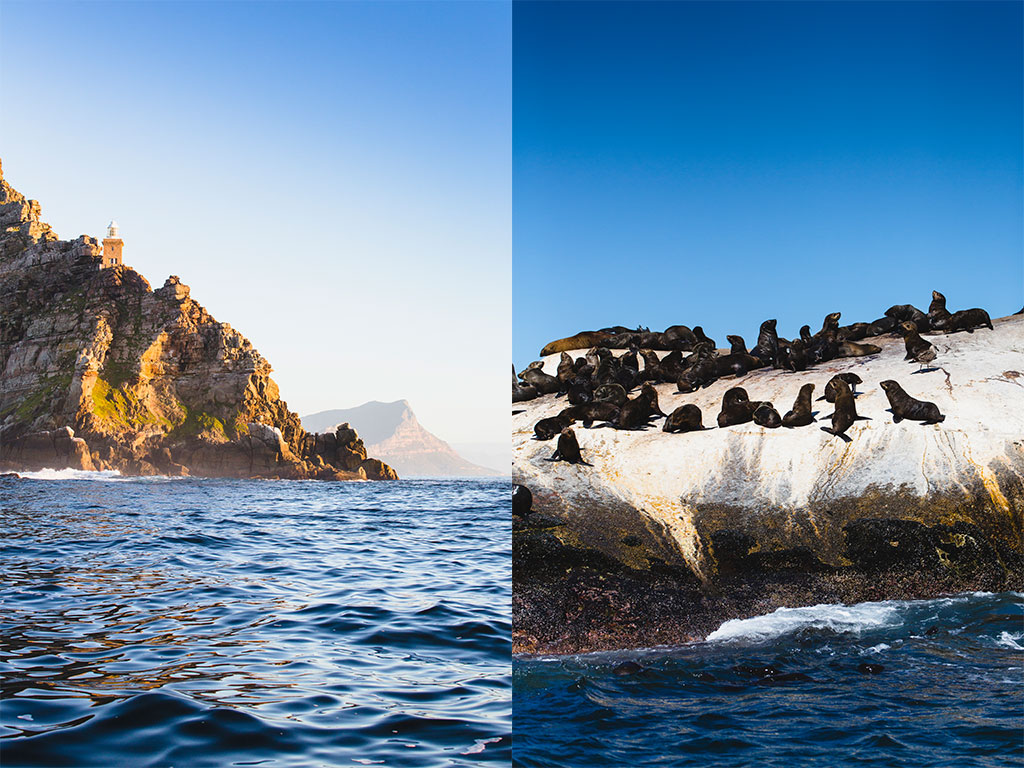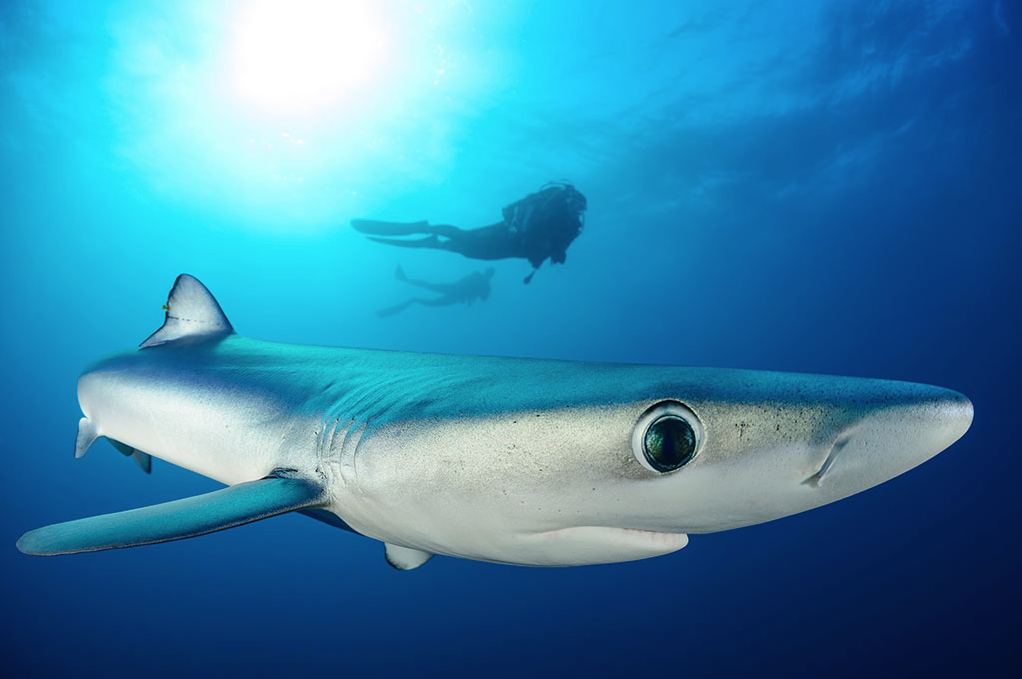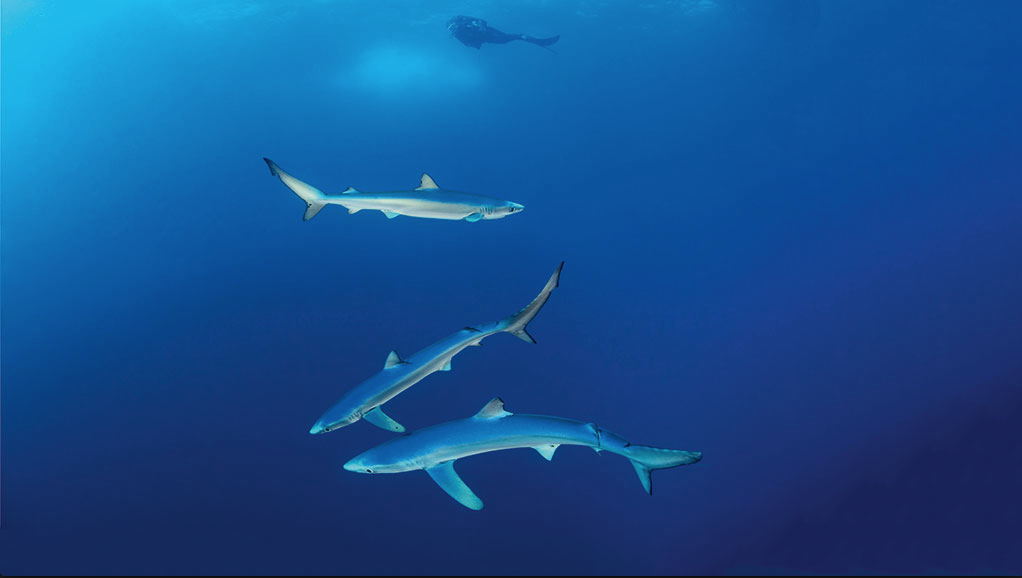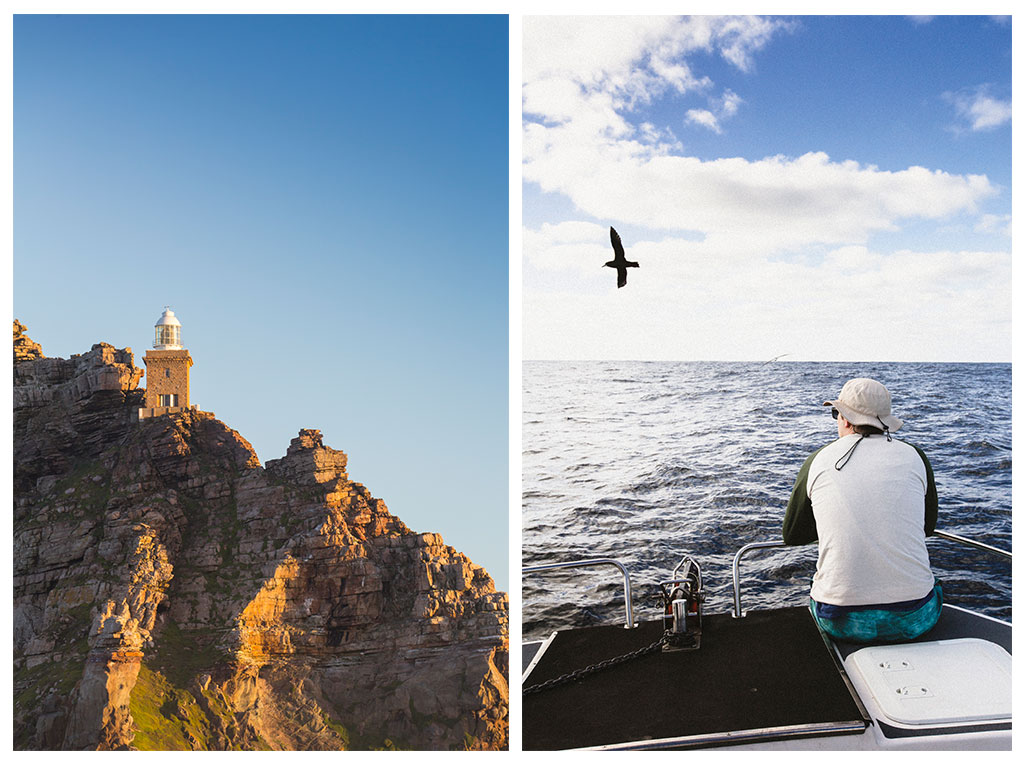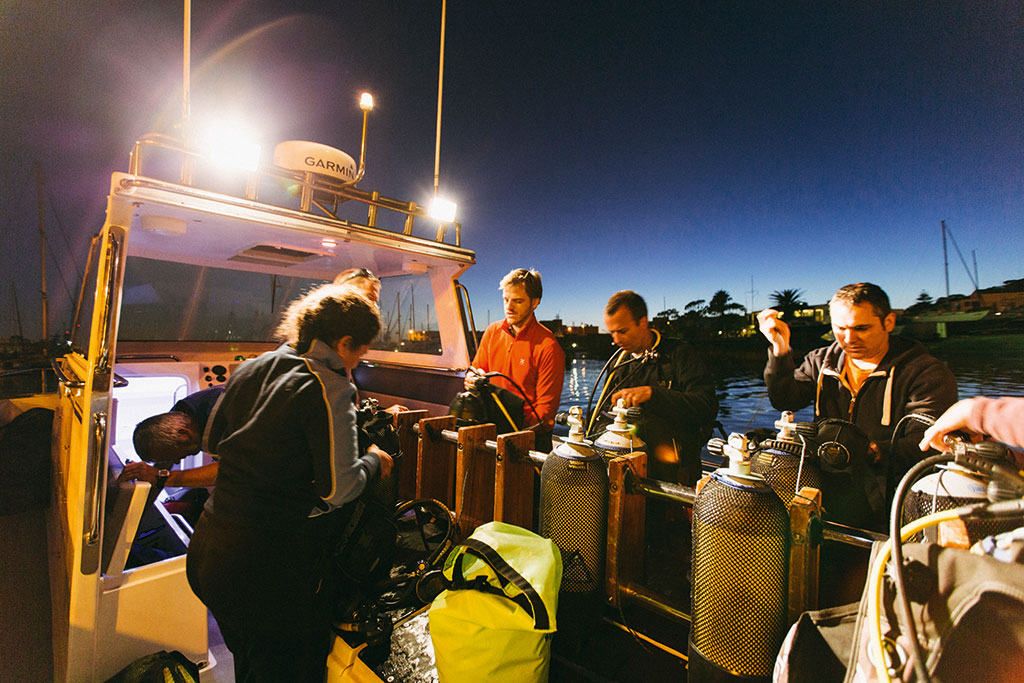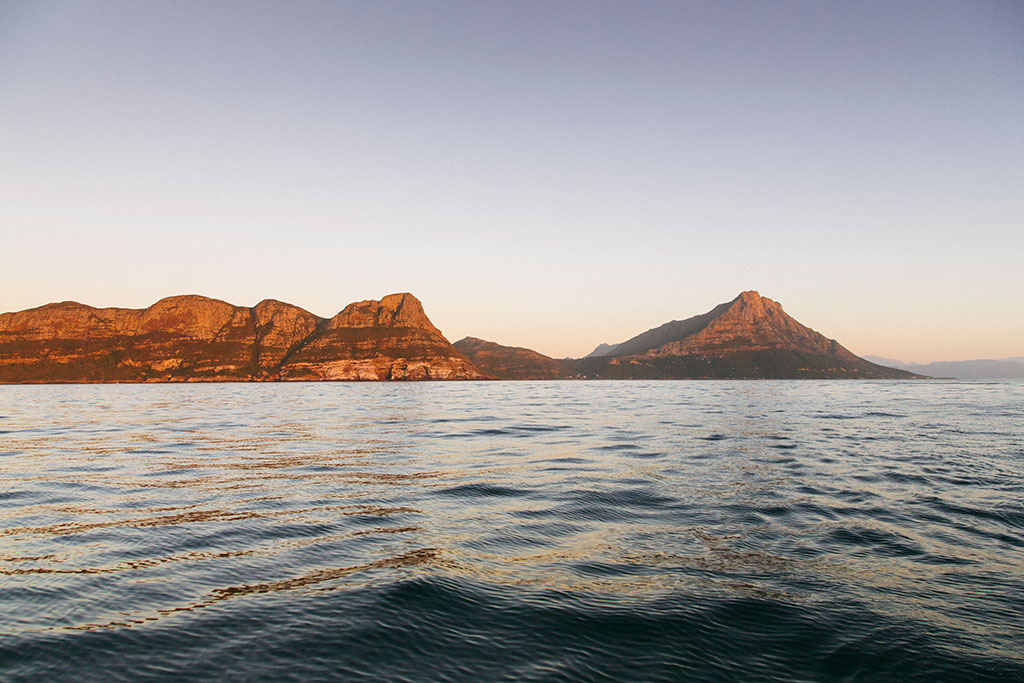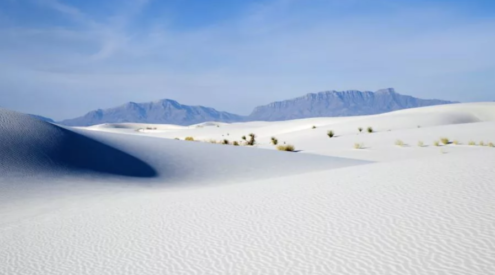There’s nothing quite as magical as being suspended in a warm, cobalt ocean with friendly blue sharks.
Teagan is afraid of sharks. Everyone is afraid of sharks but she’s really afraid of sharks, which is noticeable because she isn’t afraid of many other things, but I’ve somehow persuaded her to come out on an expedition to swim with sharks in the open ocean without a cage. Teagan is Getaway’s photographer.

Blue sharks are tactile and inquisitive, making frequent physical contact with divers. Photo by Poelzer Wolfgang
So we’re somewhere south of Cape Point on a clear warm day in April, and I have a pocketful of anxiety pills in case she needs them. She seemed cheerful enough during the long ride out, but now we’re bobbing in the deep blue and there’s something about bobbing in the deep blue with time on your hands, waiting for sharks to arrive, that makes a person start to think.
She’s starting to get fidgety and frowny and take long, suspicious looks at the sea, but fortunately a sunburnt Brit in a yellow T-shirt becomes spectacularly seasick and that cheers her up. Every shark trip needs a seasick Brit: it’s always comforting to see someone more miserable than you.
There’s a perforated drum in the water, filled with sardines and pilchards sending out a scent trail that stretches silver as a fish scale across the surface of the sea. We have spent more than an hour to get here, nearly 20 nautical miles from Simon’s Town harbour to where the warm Mozambican current sheers off the continental shelf and forms a great loop in the ocean. The current shifts day by day but the best place to find pelagic sharks is just at the edge of it, where the sea temperature suddenly climbs.
It’s an early-morning start in Simon’s Town harbour, checking gear and stowing equipment before dawn. Photo by Teagan Cunniffe.
The ocean is 20 degrees and we’re right on the line where the cold-water fish and the warm-water gamefish collide. There are tuna down there, and dorado and silver clouds of yellowtail and bonito. We’ve seen gulls and cormorants and albatross and shearwaters and southern giant petrels, but we haven’t seen any sharks. Sharks are wild animals; there’s no guarantee they’ll arrive.
If they do arrive, they’ll be blues. Sometimes you see a mako, the fastest shark in the sea: three metres of fast-twitch muscle, a torpedo with teeth, shaped like a sleeker, pointier great white. I would love to see a mako – I’ve spent 20 years trying to see one – but they are skittish and rare and I have never had any luck. You can break your heart waiting to see a mako.
I tell Teagan this. ‘I don’t want to see a mako,’ she says.
An hour passes, just bobbing, and the Brit is wishing a shark would eat him so he can stop throwing up. His girlfriend started off rubbing his back sympathetically but now she’s throwing up too – it’s a hard Brexit off the side of the boat for both of them. Teagan is starting to relax.
Cape Point and its lower lighthouse by the first golden light of day; the old man and the sea and pelagic seabirds. Photos by Teagan Cunniffe.
‘There’s a shark,’ says someone from the front of the boat. When shot-down pilots and sailors from sinking ships in the Second World War found themselves floating, the first shark they encountered were usually blue sharks (Prionace glauca), but almost none were eaten by them. In the history of shark attacks, very few deaths have been pinned on blues.
There are more blue sharks than just about any other shark in the seas, but they’re hovering on the brink of being a threatened species; up to 20 million of them a year are caught and killed for their meat and their fins and the oil in their livers. They’re exceptionally beautiful, about two metres long and as smooth and slender as stockinged legs. Their backs are a rich deep blue, a purple flecked with mica, and their bellies are the softest creamiest white.
They’re also very curious, like puppies: when you get in the water they rush over to greet you and they like to bump and jostle. Sometimes they glide directly for you in a graceful game of chicken then tilt a fin to veer away at the last minute, running the length of their body against you. If they weren’t so lovely it would be a kind of sexual harassment.
Teagan sits on the side of the boat, fumbling with her dive mask. ‘You okay?’ ‘I’m okay,’ she says, which is what people say when they aren’t okay. Then she jumps over the side.
You can stay snorkelling on the surface, or you can scuba down the five or 10 metres to hover midwater alongside the drum of sardines. The sharks come to you whichever you do but for maximum exposure and 3D immersion I recommend the scuba. There’s something splendid and hallucinatorily surreal about being suspended in the warm blue with no seabed below you, enveloped in a cloud of 20 or 30 sharks, like a nucleus surrounded by a calm eccentric orbit of elongated electrons.
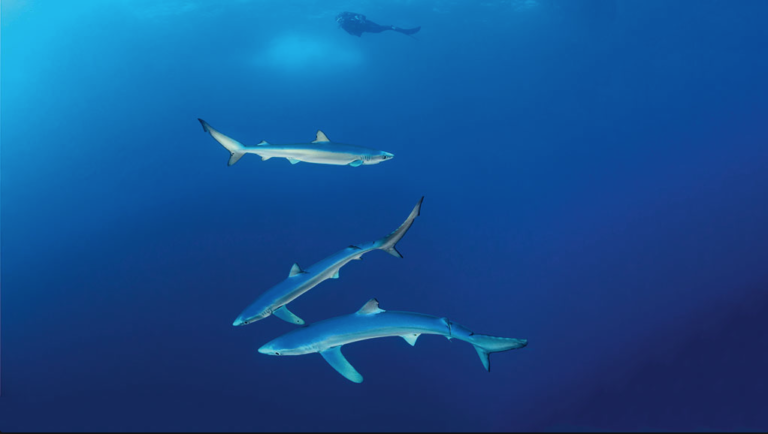
Blue sharks are more a principle of space and the ocean than they are fish, with a tender beauty too fleeting to fully grasp. Photo by Poelzer Wolfgang
It takes some time to get used to being bumped from behind and below, and even more time to stop swinging round or jerking your head up and down to see where they are. You can’t see where they are: they are everywhere.
After a while you start to tell them apart and detect personalities. The big one trailing the fishing line from the corner of his mouth keeps his distance then suddenly rises towards you from below but never makes contact; the long one with the notch in his tail likes to rub against your tank; those two almost-turquoise-coloured ones are always near each other, like a pair of young lovers.
It’s unlikely you’ll ever see a blue shark unless you go out to the open water. They travel vast distances between continents but they prefer to stay deep, in 30 metres of water or more, hunting squid and pelagic octopus. They seldom come near shore and you can’t keep them captive either; they usually die within days of being in a tank.
Like most pelagic sharks they have a poor sense of confined space – they collide with the glass and become confused by the shallowness. The longest they’ve lasted in a San Diego aquarium is three months, in a large deep circular tank where they could ride an endlessly circulating current, but to see the blues in the open sea is to understand that keeping them in captivity is like putting river water in a bathtub. It’s the same thing, but it isn’t at all the same thing.
I try to meditate every morning, and now when I do I like to think about that hour I spent in the deep blue, watching them circle and soar and dart like bright blue shadows, fast and slow, near and far. They sing a kind of story of space and motion that I haven’t seen from any other fish or sharks or any other creature other than half-remembered from my childhood dreams of flying.
Back on board, Teagan is beaming like someone who was scared of flying but has just returned from space. The others tell me that the mako came when I was down there but I didn’t see it. It came around the outside, a blue shadow in the blue, and I was looking somewhere else. I don’t mind. I’ll see it another time, or when it’s ready for me, or never. All you can do is go looking; you can’t be greedy.
Ethics of shark diving
‘This debate is complex. Briefly, it depends on the species (there are over 530 sharks) and their habits, whether they’re migratory or resident. Blues and makos are highly migratory pelagic species, so the long-term effects of chumming on their behaviour are likely minimal. The things to consider are the method of chumming and feeding. If the shark receives a reward for being there, that could have a negative effect. That said, one also has to consider the energy they’re expending and if they’re not getting food to replenish themselves, that could be negative.
The SA government has very little funding allocated towards important shark research, which is necessary to understand shark behaviour and movement ecology. One has to also consider that shark tourism places a value on the sharks being alive, plus the tourism boats provide a policing entity and often have biologists aboard. Blue sharks are a Near Threatened species on IUCN and mako sharks are classified as Vulnerable, yet both are caught in commercial fisheries off Southern Africa.’ Alison Towner, marine biologist for Dyer Island Conservation Trust and PhD candidate.
Plan your trip to swim with sharks
Getting there
Leaving False Bay as dawn breaks. Photo by Teagan Cunniffe.
When to go
Pisces Divers runs pelagic safaris between November and June. The water is always warm but the summer months tend to offer slightly flatter seas and warmer surface conditions.
Need to know
It’s an early start and a tiring day, physically and emotionally, so be sure to get to bed early the night before. Depending on how long you have to wait for the sharks to arrive – usually about an hour, but sometimes longer – you can expect to be back in harbour in the early afternoon. If you’re planning to dive you’ll need a basic scuba qualification – the conditions are very easy and unchallenging – but if you don’t dive, you will have a fulfilling time snorkelling on the surface. Freedivers are welcome; indeed, conditions are ideal for freediving. This is a no-contact dive, but should a blue happen to bump you as it swims by, you’ll find it to be surprisingly velvety and sensual and receptive to your touch.
What to bring
A towel to dry off and a warm top for the early morning and the ride back. Don’t forget sunblock and a floppy hat – the sun out at sea finds another level of burn – plus seasickness tablets if you’re susceptible.
The shark dive
A Pelagic Shark Dive costs R2500 per person (the rate is the same for snorkelling). All gear and wetsuits are supplied by Pisces Divers, are in good condition and included in the cost. Lunch is provided but bring your own snacks and treats, especially if you are a little nervous: extra sugar is comforting and is good for keeping your nerve up. One of the highlights of the trip is passing Cape Point at sunrise. It’s a uniquely beautiful view from the water, with its two lighthouses and its sheer cliffs lit gold. Keep your eyes peeled for other marine life: dolphins, seals, whales, penguins, pelagic seabirds, even turtles and the pod of orcas that has taken up residency in False Bay in recent years. (The population of sevengill cowsharks at Miller’s Point near Simon’s Town has been devastated in recent years by the orcas neatly and surgically removing their oil-rich livers.) piscesdivers.co.za
Stay here
Smitswinkel Tented Camp is in Table Mountain National Park and is an affordable, attractive option. It’s close to Cape Point and a short drive from Simon’s Town. From R670 per tent (sleeps two). sanparks.org
This underwater adventure first appeared in the October issue of Getaway magazine.
The best guide to weekending in Golden Gate; how to go shark diving (without a cage); exploring the high peaks of the Rwenzoris and heritage homestays with delicious food in Kerala.










